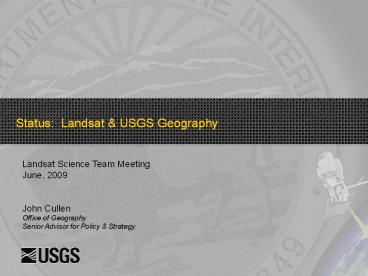National Land Imaging Program Overview - PowerPoint PPT Presentation
1 / 8
Title:
National Land Imaging Program Overview
Description:
This plan is due to the House and Senate Committees on Appropriations no later ... Optimize the satellite development schedule to achieve the shortest possible ... – PowerPoint PPT presentation
Number of Views:14
Avg rating:3.0/5.0
Title: National Land Imaging Program Overview
1
Status Landsat USGS Geography
Landsat Science Team Meeting June, 2009 John
Cullen Office of Geography Senior Advisor for
Policy Strategy
2
Current Topics of Note
- LDCM Progress / TIRS
- LDCM Ground System Strategy Modification
- EROS Contracts Recompete
- NASA OCO / TIRS Decision Process
- EROS in Transition
- EROS Director
- Web-enabled Landsat Archive
- New Approaches for EROS Data Operations
- Geography Science Strategy
- Linkage to USGS Science Strategy
- Harnessing the National Map
- Ecologic Carbon Sequestration
- Landsat Report to the Appropriations Committees
3
LDCM Progress / TIRS
- LDCM Ground System Strategy Modification
- Ground System PDR moved to being just prior to
LDCM System PDR - Benefit from existing Landsat web-enabled
infrastructure - Better suits available funding
- EROS Contracts Re-compete
- Notice to vendors posted February 27
- RFP Release anticipated by late Summer 2009
- Contract Award scheduled for April 2010
- NASA OCO / TIRS Decision Process
- TIRS achieved successful PDR
- NASA examining 3 options for OCO accommodation,
including 2 OCO / TIRS combinations - USGS Position No OCO / TIRS Combination is
acceptable - Working to stop NASA pursuing these 2 options
4
EROS in Transition
- USGS pursuing DOI approval for EROS Director SES
- Will result in a National Search
- Recognized leader in space and Earth science
needed - Web-enabled Landsat Archive
- Remarkable achievement denotes the significance
of Landsat - Bolsters the argument for National Land Imaging
- New Approaches for EROS Data Operations
- Need to examine post-Landsat 8 Era Operations
- Role of the National Archive
- Right-sized Infrastructure for Extensible Data
Operations - Coordinated Global Land Measures and
Constellation Science - Multinational Contingency Data Operations
5
Geography Science Strategy
- Linkage to USGS Science Strategy
- Examining relationship of Geography to USGS
Science - Beyond Imagery and Cartographic representation
- Multi-dimensional spatial coordination of
physical science, demography, and socio-economics - Variables, processes, models, and questions of
merit - Climate Global Change, Land Management,
Ecosystem Services - Harnessing the National Map
- Restoring USGS map production services
- Focus on layers needed for modern GIS
- Vehicle for USGS science integration and delivery
- Ecologic Carbon Sequestration
- Partnership between USGS Geography and Biology
Disciplines - Energy Independence and Security Act of 2007
- Emerging Cap-and-Trade and Copenhagen processes
- Obama Administration focus on Energy and Climate
6
USGS Science Strategy
7
Landsat Report to the Appropriations Committees
- NASA is further directed to develop, in
cooperation with the Office of Science and
Technology Policy (OSTP) and the U.S. Geological
Survey (USGS), a plan for a follow-on mission to
LDCM consistent with the recommendations of the
National Science and Technology Council's report,
A Plan for a U.S. National Land Imaging Program.
This plan is due to the House and Senate
Committees on Appropriations no later than August
31, 2009. - Draft in preparation
- Defines Landsat Continuity Component Parts Data,
Operations, Management, Measurement, Mission,
Technology, and Policy Continuity - Consistent with OSTP NLI Recommendations
- Anticipate support from DOI, OMB/OSTP, and
Congress - USGS will also need to address jurisdictional
questions about source of Congressional
Appropriations
8
Landsat 9 Requirements (from current draft of
Congressional Report)
- The technical design of a follow-on mission to
LDCM should meet the following guidelines - Ensure the highest level of mission continuity
possible given the fact that Landsat-8, should it
survive launch, is likely to be the only Landsat
satellite on orbit for a number of years. - Optimize the satellite development schedule to
achieve the shortest possible time between
Landsat-8 and Landsat-9 launches, given the
possibility of losing Landsat-8 at the time of
launch. - At minimum, meet the same system and subsystem
reliability characteristics as Landsat-8. - If possible, advance the satellite systems
technical performance requirements to achieve
greater temporal frequency of coverage of the
Earths surface and greater levels of spatial
resolution. - Consider adopting spectral bands to make Landsat
compatible with the European Sentinel-2
satellite, a potential sister companion to future
Landsat satellites. - If possible, provide accommodations for testing
and demonstrating future-generation land imaging
instrument technologies for consideration for
adoption aboard future NLI operational satellite
systems. - Provide for on-going upgrade to the EROS archive
and ground data processing systems necessary to
receive, archive, process, and distribute
satellite and aerial data from sources that
complement and enhance United States scientific
and operational purposes.































